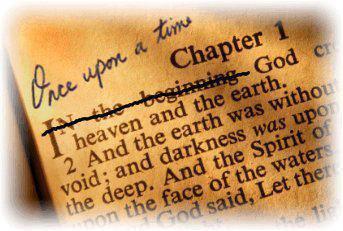Until recently, my full-time job was talking about Jesus and the Bible with people who didn’t know much about them, first in Central Asia and then among international students at university. So, you’d think, given my background, that the idea of talking about God with my kids would seem like cake.
It doesn’t. It feels like I could easily do or say the wrong thing and turn my kids off of Jesus forever. So, even though Oliver’s only 16 months and Margot 3 months, I picked up my first book about sharing Jesus with my kids from our great local library. I picked up the book, Telling God’s Story: A Parents’ Guide to Teaching the Bible by Peter Enns, because I respect Enn’s work as a biblical scholar and thought he would offer a more nuanced take than other similar books. I’m really excited to try his approach with our kids.The book helps lay the foundation for three sets of other books, Years 1, 2, and 3. Each year (a misnomer, really, since they’re actually divided by stage of life) includes an instructor text and a student guide with activity pages. I haven’t seen the student guide, but I skimmed through the instructor text. This post isn’t going to focus on those books, though, since we’re still a few years away from needing them, but if your kids are bigger, you should certainly check them out. Instead, I’ll tell you about the Parent’s guide because it helps with one of the biggest problems that many parents face when trying to teach their kids about the Bible:
 Parents quickly realize that they don’t have a firm grasp of the Bible either.
Parents quickly realize that they don’t have a firm grasp of the Bible either.
Growing up, I had a lot of wacky and confusing ideas about God and the Bible, some from pop culture (we become angels when we die, right?) and some from my middle school churchgoing experience (writing down your “vision” and making it plain makes it extra likely to happen!). So Enns spends the first part of the book talking about what the Bible is—and what it isn’t.
One of the most helpful things for me was his comparison of the parallels between Jesus and the Bible: they were both divine and human; Jesus didn’t sin and equally the Bible does not misrepresent God; the power and authority of each is derived from God; and, crucially, just as Jesus seemed like any other first-century Palestinian Jew, so the Bible appears like other ancient books. For example, instead of using high, polished, classical Greek, the New Testament was written in a simple, common, everyday Greek. Not something you might expect from “God’s Word.”
He also points out that the Bible is also not a rule book or owner’s manual, and so we shouldn’t expect it to act like one. Instead it requires wisdom. And that’s one of the hardest thing as a parent. We want to just tell our kids, “Do this, not that. Here’s the verse, that settles it.”
But we shouldn’t settle for expediency and short-term results—we have to do the difficult work of acting in wisdom by teaching wisdom to our kids.
As such, like I mentioned earlier, Enns divides the series into three “years”—The Elementary Years, The Middle-Grade Years, and Grades 9-12. In the Elementary Years, the focus is on helping our kids to know Jesus. Since the point of Scripture is Jesus (as Jesus Himself says), we should make Him the foundation for our kids. In the Middle-Grade Years, Enns moves on to helping our kids get the larger vision of Scripture, with the idea being that once they know where the story’s going (Jesus), the rest of the Bible won’t seem like a random collection of stories, but something coherent. We shouldn’t get bogged down in the details, but help them get to know the basic flow of the Bible. Finally, in the high school years, we should help our teens (that’s scary to write down!) to begin to interact with the Bible in its historical context. Many kids too often don’t learn this lessons from their parents or church communities and then encounter strange and confusing ideas out in “the world.” (I’m thinking specifically of The Da Vinci Code and the confusion that one of my friends in high school went through.)
But what about other ways of teaching the Bible?
 As I read Enns’ approach, I liked it but thought, what about teaching the Bible stories first, like Noah and the Flood or David and Goliath? That’s the way I’ve typically seen it done. Enns says that some of these other approaches short change the Bible. One of the problems with the “Bible Story” approach (teaching those action-packed stories like the Flood and the Exodus) is that they have the feeling of being children’s stories, and so just as our kids will begin to understand that there aren’t really talking puppies or fairies or magic snow queens as they age, we don’t want these stories that can easily feel similar to be in the same category for them.
As I read Enns’ approach, I liked it but thought, what about teaching the Bible stories first, like Noah and the Flood or David and Goliath? That’s the way I’ve typically seen it done. Enns says that some of these other approaches short change the Bible. One of the problems with the “Bible Story” approach (teaching those action-packed stories like the Flood and the Exodus) is that they have the feeling of being children’s stories, and so just as our kids will begin to understand that there aren’t really talking puppies or fairies or magic snow queens as they age, we don’t want these stories that can easily feel similar to be in the same category for them.
Enns also mentions the “Character Study” approach where we look at the lives of important biblical characters like Samson or Moses. The problem with this approach, he says, is that the main point of these stories is not that we should emulate the lives of these people but that they point to God’s righteousness and faithfulness, even in the face of our sin and unfaithfulness.
Additionally, “Book-by-Book” approaches fail because kids just don’t have adult attention spans. (Heck, many adults don’t have adult attention spans.) And the “Defensive” (or Apologetic) approach makes the Bible all about conflicts, bypassing the foundation Enns argues for in this book. Our kids can learn about the difficulties and controversies when they’re older (how old is the earth? why do these parallel stories differ? etc.).
Finally, Enns finishes the book with a lengthy and helpful recap of the whole Bible, broken down into Creation, Fall, and Redemption (with Redemption further subdivided into Abraham, Moses, David and Kingship, Return from Babylon, and Jesus). It was definitely familiar material for me, but for many parents it can be incredibly helpful. It reminded me a lot of the summary of the Gospel in Scot McKnight’s King Jesus Gospel, which I’ve used multiple times to share the good news with some of my international friends. It really helps you see how everything ties together.
Overall, I think this book and this series will be really helpful as Elisa and I seek to teach our kids about who Jesus is and what the Bible is. Teaching Jesus first creates a good foundation, upon which we can then build hooks to add the details of the Bible to later. My only criticism is that it doesn’t really offer insight in how to approach Bible teaching in the pre-K years that we’re in now, so I guess I’ll stick to reading the kid’s Bible that we own and trying to talk about Jesus as much as possible.
How do you teach or plan to teach the Bible to your kids? What are some of the difficulties that you’ve faced? What are some helpful tips you might have for other parents like us?




